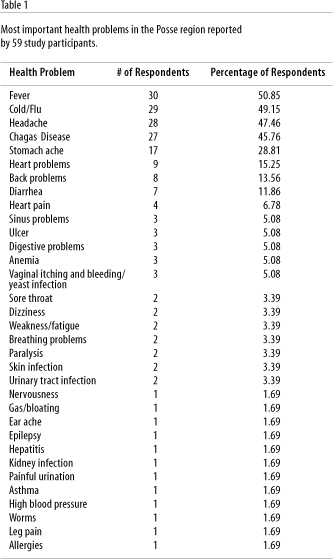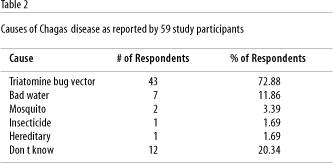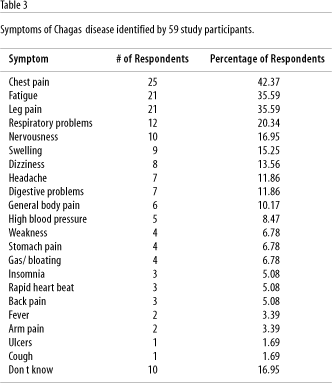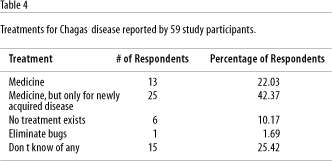| Sarah Williams-Blangero 1 John L. VandeBerg 1 Antonio R. L. Teixeira 2 | Attitudes towards Chagas' disease in an endemic Brazilian community Crenças populares relativas à doença de Chagas em uma comunidade de área endêmica do Brasil |
| 1 Department of Genetics, Southwest Foundation for Biomedical Research. P.O. Box 760549, San Antonio, Texas, 78245-0549, USA. 2 Laboratório Multidisciplinar de Pesquisa em Doença de Chagas. C. P. 4536, Campus Universitário Asa Norte, Brasília, DF 70919-970, Brasil. | Abstract Chagas' disease remains a major public health concern throughout much of Latin America. In Brazil, segments of the population experience Trypanosoma cruzi infection rates as high as 65%, indicating that control programs are still needed. Few data are available concerning people's health beliefs related to Chagas' disease in heavily infected populations. Such health beliefs may significantly impact the effectiveness of intervention schemes. The purpose of this study was to assess health beliefs related to Chagas' disease in a population experiencing high infection rates with the causal parasite. The focal population for the study consisted of the residents of Posse, a rural community in the State of Goiás. The results indicate that a majority of the population had a high degree of knowledge about Chagas' disease and the vector involved in its transmission. These findings indicate that control programs conducted by the Brazilian Ministry of Health have included effective educational components. Key words Knowledge, Attitudes, Practice; Trypanosoma cruzi; Chagas Disease Resumo A doença de Chagas persiste como importante problema de saúde pública em grande parte da América Latina. No Brasil, vários segmentos da população apresentam taxas de infecção pelo Trypanosoma cruzi que chegam até 65%, sugerindo que os programas de controle ainda são necessários. Há poucos dados disponíveis sobre as crenças populares relativas à doença de Chagas entre comunidades com altas taxas de infecção. Tais crenças podem ter um impacto significativo sobre a eficácia das intervenções. O objetivo deste estudo é avaliar as crenças relativas à doença de Chagas numa população com altas taxas de infecção pelo agente etiológico da doença. A população-alvo do estudo foi composta de moradores da Posse, uma comunidade rural no Estado de Goiás. Os resultados indicam que a maioria da população tinha um alto grau de conhecimento quanto à doença de Chagas e seu vetor. Os achados apontam para a eficácia dos componentes educativos dos programas de controle implementados pelo Ministério da Saúde. |
Chagas' disease is an extreme consequence of infection with the parasitic protozoan Trypanosoma cruzi. The disease continues to be a major public health concern throughout Latin America, despite numerous control and eradication programs. It has been estimated that between 16 and 18 million people are infected with T. cruzi and that 100 million more individuals are at risk of infection (PAHO, 1990).
T. cruzi is transmitted to humans by several genera of triatomine bugs, including Triatoma, Rhodnius, and Panstrongylus (Nogueira & Coura, 1990). Transmission occurs subsequent to the blood meal, when feces deposited by infected bugs come into contact with open wounds or mucous membranes (Nogueira & Coura, 1990).
Houses with thatched roofs and/or mud walls provide a multitude of sites for the triatomine bug vector to inhabit, and evidence of infestation of these types of dwellings in Latin America dates to prehistoric times (Garcia-Zapata & Marsden, 1986; Coimbra Jr., 1988; Gurtler et al., 1992). T. cruzi has a broad range of hosts, including such domestic animals as goats, sheep, guinea pigs, dogs, and cats (Garcia-Zapata & Marsden, 1986; Gurtler et al., 1992). Chickens, while not a host of T. cruzi, provide a source of blood meals for the triatomine bugs and are commonly kept in the yards of houses in the study area. Keeping such domestic animals in close proximity to the house may encourage proliferation of the household bug population. Intensity of bug infestation has been shown to be directly correlated with risk of T. cruzi infection in household residents (Piesman et al., 1985). Epidemiological patterns of T. cruzi infection have been suggested to reflect variation in household risk factors (Mott et al., 1976).
Chagas' disease generally occurs in two phases. First, there is an acute phase lasting 2-3 months following parasitic infection, with possible formation of a characteristic swelling or chagoma at the infection site (Nogueira & Coura, 1990). Many individuals remain asymptomatic throughout the acute phase of the illness, although between 5% and 10% of individuals experience severe, sometimes fatal, disease during this phase (Nogueira & Coura, 1990). About 40% of those infected recover spontaneously from the acute phase and remain seropositive but disease-free for the remainder of their lives. In the remaining 60% of cases the disease enters a quiescent period lasting as long as 30 years, until the onset of the chronic phase, which can be characterized by progressive cardiomyopathy, megacolon, and/ or megaesophagus (Morris et al., 1990; Nogueira & Coura, 1990).
There are currently no prophylactic drugs available to prevent infection with T. cruzi (Castro, 1993). Chemotherapy for T. cruzi infection has centered on the use of two nitroarenes, Nifurtimox and Benznidazole. These drugs are effective in decreasing early parasitemia, but their utility during the chronic phase of Chagas' disease is questionable (Garcia-Zapata & Marsden, 1986; Castro, 1993). Both drugs have severe side effects and are carcinogenic in rabbits (Garcia-Zapata & Marsden, 1986; Teixeira et al., 1990a, 1990b).
Despite extensive biomedical research on Chagas' disease, relatively little information has been generated regarding people's perceptions of the disease, T. cruzi infection, or the relative importance of this disease in endemic communities. A survey of Mambaí, in the State of Goiás, Brazil, where 33% of individuals were seropositive and 32% of houses were infested with the vector, revealed that most individuals had knowledge of both the vector and the characteristics of Chagas' disease (Bizerra et al., 1981). Almost everyone reported that the bugs were the cause of the disease, 84% of individuals understood the type of disease transmitted by the vector, and 56% recognized that control of bug infestation was important. At the time of the study, Mambaí had been the focus of a long-term research project on Chagas' disease and was also the site of a regional health post. This study suggested that the public health programs had been successful in their educational efforts.
The authors also applied their survey to a rural community that lacked a health post and was not included in the original study (Bizerra et al., 1981). Similar to the situation in Mambaí, most individuals that were interviewed agreed that triatomine bugs were harmful and transmitted disease. However, only 55% of the residents of the rural community were knowledgeable of the characteristics of Chagas' disease. Despite decreased awareness of the signs and symptoms of Chagas' disease in this community as compared to Mambai, 71% of individuals recognized the importance of bug control in diminishing disease rates. Even in the absence of a local health post, control programs had a significant impact on transmission of information about the Chagas' disease vector.
Conversely, a recent study in Guatemala focusing on an area with a seropositivity rate of approximately 11% suggested that none of the residents knew of Chagas' disease as a specific disease entity (Nix et al., 1995). No signs or symptoms described as resulting from bites by triatomine bugs were associated with Chagas' disease (Nix et al., 1995). However, many people were aware of the bugs, which they considered a household nuisance (Nix et al., 1995).
High rates of recognition of the role of triatomine bugs in Chagas' disease as reported by Bizerra and colleagues (Bizerra et al., 1981) stand in contrast to many reports on knowledge and attitudes for other vector-transmitted diseases. For example, malaria studies have frequently shown a lack of accurate knowledge about disease etiology in high-risk areas. A survey conducted in five West African communities showed that only 25-50% of residents identified mosquitoes as the cause of malaria (Aikens et al., 1994). A survey of residents in a coastal plain area in Guatemala found that while 93% of individuals recognized that a mosquito which had previously bitten a malaria patient could transmit the disease, a variety of other causes were believed to exist (Ruebush et al., 1992). Fifty percent of residents thought that houseflies could also transmit the disease, 77% thought malaria could result from drinking unboiled water, 77% felt that bathing too frequently could result in malaria, and 62% implicated lack of sleep as a causal factor (Ruebush et al., 1992).
Lymphatic filariasis is another mosquito-borne disease which has been the focus of large-scale intervention programs. As reviewed by Evans et al. (1993), studies of local knowledge of disease causation in endemic communities have generally shown a variety of alternative causal explanations. Filariasis has been attributed to contact with cold water (Schultz, 1988), consumption of contaminated foods or drink (Carme et al., 1979; Haliza, 1986), and aggravation of physical injury (Carme et al., 1979). A survey in a Malaysian community where 6% of individuals were infected with Brugia malayi found that only 8% of individuals identified the mosquito as the cause of filariasis, and 42% responded that they could not identify the cause of filariasis (Haliza, 1986). Likewise, in an endemic area of Tahiti which had been the focus of an antifilarial campaign for over 25 years, only 13% of filariasis patients identified mosquitoes as the cause of infection as compared to 41% who attributed the disease to ankle injuries (Carme et al., 1979). A study of an endemic area in Haiti showed that only 13% of residents who recognized filariasis attributed the disease to mosquito transmission, while 48% attributed the disease to contaminated soil or water (Eberhard et al., 1996).
Onchocerciasis is a filarial infection transmitted by blackflies (Otteson, 1990). A survey of attitudes towards this disease among heads of households in an endemic area of Guatemala showed that only 50% of individuals recognized the role of an insect bite in disease transmission (Richards et al., 1991). Other purported causes included consumption of poor-quality foodstuffs or water and physical injury (Richards et al., 1991).
The literature suggests that knowledge of vector transmission is frequently poor in areas endemic for vector-transmitted diseases. A high prevalence of alternative explanations for disease causation has significant implications for the potential efficacy of intervention programs (Evans et al., 1993; Aikens et al., 1994). Local beliefs about disease causation should be assessed to determine if public health education programs are effective, and such evaluation should be performed periodically to ensure that the quality of education is maintained and that accurate information is being appropriately transferred to the at-risk population.
The purpose of this study was to assess local attitudes and beliefs about Chagas' disease in an endemic area of Brazil. This area has been the focus of an active Chagas' disease control program by the Brazilian Ministry of Health for over a decade.
Materials and methods
We interviewed adults representing 59 households located in the Posse area, which is endemic for Chagas' disease. Over 60% of adults in this farming county are positive for infection with T. cruzi (Williams-Blangero et al., 1997). Active transmission of T. cruzi infections still occurs, despite insecticide spraying and home-building improvement programs which have been operating in the area for the last 14 years (Sgambatti de Andrade et al., 1995). A recent survey of 1,931 individuals from the region indicated that 5% of children aged 10 years or under, 17% of individuals between the ages of 10 and 15 years, 29% of individuals between the ages of 15 and 21 years, and 61% of individuals over 21 years were seropositive for T. cruzi (Teixeira, personal communication).
An interview guide was used to elicit general health concerns and attitudes towards Chagas' disease in particular. All interviews were conducted in Portuguese at the homes of the sampled individuals. Nineteen men and forty women, each living in a different household, were sampled in a house-to-house survey of 4 villages in the area. The population is an admixed population with European, African, and Amerindian genes represented. Sampled individuals ranged in age from 20 to 79 years, with a mean age of 38.5 years. Individuals were asked about the most important health problems in Posse, whether or not Chagas' disease is an important health problem, the causes of Chagas' disease, symptoms of Chagas' disease, treatments for Chagas' disease, and presence of triatomine bugs in and around the household.
Results
Perceived Health Problems in Posse
Individuals were asked to identify the most important health problems for people residing in the Posse area. Fever was the most frequently mentioned health problem, identified by 50.8% of the sampled individuals. Colds and flu were mentioned as major health problems by 49.2% of the sample, and headache was identified as a major health problem by 47.5% of sampled individuals. Chagas' disease was identified spontaneously by 45.8% of the sample as being a major health problem for residents of the Posse area. Other commonly mentioned health problems included stomach ache (28.8%), heart problems (15.3%), back problems (13.6%), and diarrhea (11.9%). Table 1 provides a complete listing of the health problems identified by the 59 sample individuals. The listing includes a mixture of both specific diseases and general symptoms.

We then asked specifically if Chagas' disease was an important health problem in the Posse area, and 86.4% of the sample replied in the affirmative, often noting that they knew many people who had the disease. Seven individuals did not consider Chagas' disease an important health problem in the area, and one person did not know whether or not the disease was a major concern in the region.
Causes of Chagas' Disease
Responses regarding causation of Chagas' disease are summarized in Table 2. When asked how an individual acquires Chagas' disease, 72.9% reported that one gets the disease from the barbeiro (triatomine bug vector). Thus, the majority of individuals were aware of the vector involved in the disease transmission. Several other causes of Chagas' disease were also reported, including bad water (11.9%) and mosquitoes (3.4%). One individual attributed the cause of Chagas' disease to the insecticide used to kill the triatomine vectors. Twelve individuals (20.3%) responded that they did not know the cause of Chagas' disease or how one could catch it. One person suggested that the disease was familial, an observation consistent with a recent genetic study of susceptibility to infection with T. cruzi (Williams-Blangero et al., 1997).

Symptoms of Chagas' Disease
The majority of individuals interviewed had accurate knowledge of the symptoms experienced by individuals with Chagas' disease, as shown in Table 3. Symptoms identified by respondents included chest pain (42.4%), respiratory problems (20.3%), fatigue (35.6%), leg pain (35.6%), nervousness (16.9%), swelling (15.3%), dizziness (13.6%), headache (11.9%), digestive problems (11.9%), general body pain (10.2%), high blood pressure (8.5%), general weakness (6.8%), stomach pain (6.8%), gas and bloating (6.8%), insomnia (5.1%), and rapid heart beat (5.1%). The range of symptoms correctly identified includes signs of cardiomyopathy and signs of gastrointestinal involvement. Only ten individuals (16.9%) were unable to identify any symptoms associated with Chagas' disease.

Treatment of Chagas' Disease
A substantial proportion of the sample (25.4%) reported that they did not know if there was a treatment available for Chagas' disease, and 10.2% of those interviewed asserted that no treatment existed. Sixty-four percent indicated that medicine for treatment of Chagas' disease was available, although over half of these individuals said that the medicine was only effective for recently acquired disease. Responses regarding treatment of Chagas' disease are outlined in Table 4. The responses accurately reflect the lack of an efficacious drug therapy for Chagas' disease during the chronic phase.

Presence of Triatomine Bugs in the Household
The success of insecticide spraying programs is indicated clearly by the fact that 95% of sampled individuals reported that they did not have triatomine bugs in the house. However, 39% of those who did not currently have bugs in the house reported that they had seen them in the household frequently prior to initiation of the insecticide spraying programs.
Discussion and conclusions
The results indicate that residents of the region of Posse have a high level of knowledge and awareness of Chagas' disease and the triatomine vector responsible for transmission of the disease. People who were interviewed readily differentiated between "Chagas' of the blood", (seropositivity) which did not necessarily result in illness, and Chagas' disease which could involve a broad range of gastrointestinal or cardiac symptoms. The triatomine vector was spontaneously identified as the cause of Chagas' disease by the majority of respondents.
These results support those of Bizerra et al. (1981) and stand in contrast to the majority of results reported for vector-transmitted diseases. We feel several reasons account for this high level of knowledge about Chagas' disease and the role of the triatomine vector in its transmission. First, the insect vector is relatively large in size, and the bite can be quite painful. Both the insect and the bite are more noticeable than for other smaller disease vectors such as mosquitoes.
Additionally, levels of infestation of the houses were very high prior to initiation of the insecticide control programs. Individuals in the study reported seeing large numbers of bugs and being bitten frequently prior to the intervention by the Brazilian Ministry of Health's programs aimed at controlling the insects. These programs are all household-based and involve spraying of the house by Ministry of Health workers. Workers wear protective clothing and instruct household members about special precautions for avoiding contact with the insecticide immediately after spraying. Thus the insecticide control program is highly visible and has a clear and direct impact in substantially diminishing the bug population inside households.
Ministry of Health personnel informally convey information about Chagas' disease and the role of the bug in transmission of disease during visits for insecticide spraying of the houses. This educational process appears to have been highly effective in establishing the link between the vector and the disease and in disseminating information about the signs and symptoms of the disease. In our experience, whenever bugs were found in the household they were collected and saved for later inspection by Ministry of Health personnel.
The Brazilian Ministry of Health has focused considerable effort on the control of Chagas' disease in the Posse area. The results of our survey indicate that these programs have effectively disseminated information about Chagas' disease and its vector to the at-risk population.
Acknowledgments
We thank the people of Posse for their gracious cooperation with the Posse Family Health Project. The Brazilian Ministry of Health provided crucial assistance and logistic support for the successful completion of this survey. In particular, we wish to thank Raul Gonçalves da Silva for his assistance during data collection. This project was supported by the Southwest Foundation for Biomedical Research and grant 6.6.91.0501.04 from the Inter-American Development Bank/FINEP, Brazil to A.R.L.T.
References
AIKENS, M. K.; PICKERING, H. & GREENWOOD, B. M., 1994. Attitudes to malaria, traditional practices and bednets (mosquito nets) as vector control measures: A comparative study in five West African countries. Journal of Tropical Medicine and Hygiene, 97:81-86.
BIZERRA, J. F.; GAZZANA, M. R.; COSTA, C. H.; MELLO, D. A. & MARSDEN, P. A., 1981. A survey of what people know about Chagas' disease. World Health Forum, 2:394-397.
CARME, B.; UTAHIA, A.; TUIRA, E. & TEURA, T., 1979. Filarial elephantiasis in French Polynesia: A study concerning the beliefs of 127 patients about the origin of their disease. Transactions of the Royal Society of Tropical Medicine and Hygiene, 73:424-426.
CASTRO, S. L., 1993. The challenge of Chagas' disease chemotherapy: An update of drugs assayed against Trypanosoma cruzi. Acta Tropica, 53:83-98.
COIMBRA Jr., C. E. A., 1988. Human settlements, demographic pattern, and epidemiology in lowland Amazonia: The case of Chagas' disease. American Anthropologist, 90:82-97.
EBERHARD, M. L.; WALKER, E. M.; ADDISS, D. G. & LAMMIE, P. J., 1996. A survey of knowledge, attitudes, and perceptions (KAPs) of lymphatic filariasis, elephantiasis, and hydrocele among residents in an endemic area of Haiti. American Journal of Tropical Medicine and Hygiene, 54:299-303.
EVANS, D. B.; GELBAND, H. & VLASSOFF, C., 1993. Social and economic factors and the control of lymphatic filariasis: A review. Acta Tropica, 53:1-26.
GARCIA-ZAPATA, M. T. A. & MARSDEN, P. D., 1986. Chagas' disease. Clinics in Tropical Medicine and Communicable Diseases, 1:557-585.
GURTLER, R. E.; CECERE, M. C.; RUBEL, D. N. & SCHWEIGMANN, N. J., 1992. Determinants of the domiciliary density of Triatoma infestans, vector of Chagas' disease. Medical and Veterinary Entomology, 6:75-83.
HALIZA, M. R., 1986. Comparison of knowledge on filariasis and epidemiologic factors between infected and uninfected respondents in a Malay community. Southeast Asian Journal of Tropical Medicine and Public Health, 17:457-463.
MORRIS, S. A.; TANOWITZ, H. B.; WITTNER, M. & BILEZIKIAN, J. P., 1990. Pathophysiological insights into cardiomyopathy of Chagas' disease. Circulation, 82:1900-1909.
MOTT, K. E.; LEHMAN, J. S.; HOFF, R.; MORROW, R. H.; MUNIZ, T. M.; SHERLOCK, I.; DRAPER, C. C.; PUGLIESE, C. & GUIMARÃES, A. C., 1976. The epidemiology and household distribution of seroreactivity to Trypanosoma cruzi in a rural community in Northeast Brazil. American Journal of Tropical Medicine and Hygiene, 25:552-562.
NIX, N. A.; HERNANDEZ, B.; MENDOZA, C. & KLEIN, R. E., 1995. Knowledge, attitudes, and practices (KAP) survey for Chagas' disease in an endemic area of Guatemala. American Journal of Tropical Medicine and Hygiene, 53:S187.
NOGUEIRA, N. & COURA, J. R., 1990. American trypanosomiasis (Chagas' disease). In: Tropical and Geographic Medicine (K. S. Warren & A. A. F. Mahmoud, eds.), pp. 281-296, New York: McGraw-Hill.
OTTESON, E. A., 1990. The filariases and tropical eosinophilia. In: Tropical and Geographic Medicine (K. S. Warren & A. A. F. Mahmoud, eds.), pp. 407-429, New York: McGraw-Hill.
PAHO (Pan American Health Organization), 1990. Brazil. In: Health Conditions in the Americas (PAHO, ed.), pp. 57-69, Washington, D.C.: World Health Organization.
PIESMAN, J.; SHERLOCK, I. A.; MOTA, E.; TODD, C. W.; HOFF, R. & WELLER, T. H., 1985. Association between household triatomine density and incidence of Trypanosoma cruzi infection during a nine year study in Castro Alves, Bahia, Brazil. American Journal of Tropical Medicine and Hygiene, 34:866-869.
RICHARDS, F.; KLEIN, R. E.; GONZALES-PERALTA, C.; ZEA-FLORES, R.; ZEA-FLORES, G. & CASTRO-RAMIREZ, J., 1991. Knowledge, attitudes and perceptions (KAP) of onchocerciasis: A survey among residents in an endemic area in Guatemala targeted for mass chemotherapy with ivermectin. Social Science and Medicine, 32:1275-1281.
RUEBUSH, T. K.; WELLER, S. C. & KLEIN, R. E., 1992. Knowledge and beliefs about malaria on the Pacific coastal plain of Guatemala. American Journal of Tropical Medicine and Hygiene, 46:451-459.
SCHULTZ, G. W., 1988. A study of Bancroftian filariasis on the islands of Batan and Rapu, Phillippines. Southeast Asian Journal of Tropical Medicine and Public Health, 19:207-214.
SGAMBATTI DE ANDRADE, A. L. S.; ZICKER, F.; SILVA, I. G.; SOUZA, J. M. P. & MARTELLI, C. M. P., 1995. Risk factors for Trypanosoma cruzi infection among children in central Brazil: A case-control study in vector control settings. American Journal of Tropical Medicine and Hygiene, 52:183-187.
TEIXEIRA, A. R. L.; CORDOBA, J. C.; MAIOR, I. S. & SOLORZANO, E., 1990a. Chagas' disease: Lymphoma growth in rabbits treated with Benznidazole. American Journal of Tropical Medicine and Hygiene, 43:146-158.
TEIXEIRA, A. R. L.; SILVA, R.; NETO, E. C.; SANTANO, J. M. & RIZZO, L. V., 1990b. Malignant, non-Hodgkin's lymphoma in Trypanosoma cruzi infected rabbits treated with nitroarenes. Journal of Comparative Pathology, 103:37-48.
WILLIAMS-BLANGERO, S.; VANDEBERG, J. L.; BLANGERO, J. & TEIXEIRA, A. R. L., 1997. Genetic epidemiology of Trypanosoma cruzi infection in rural Goiás, Brazil. American Journal of Tropical Medicine and Hygiene, 57:538-543.
